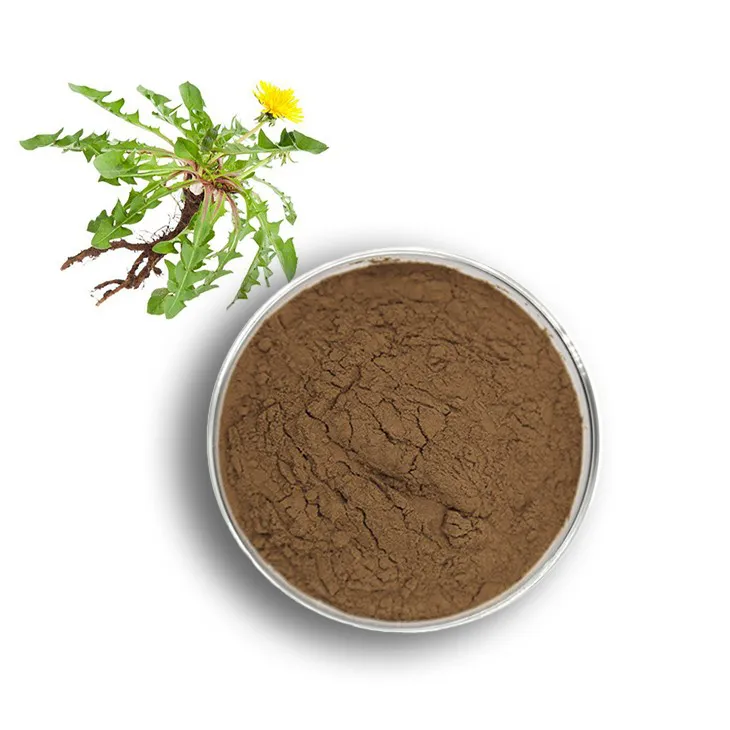- 0086-571-85302990
- sales@greenskybio.com
The best method for extracting dandelion root extract.
2024-11-29

1. Introduction
Dandelion Root Extract has been gaining increasing attention due to its potential health benefits, such as antioxidant, anti - inflammatory, and digestive - aid properties. Efficient extraction methods are crucial to obtain high - quality Dandelion Root Extract. This article will explore in - depth knowledge of extraction, including the influence of equipment, solvents, and extraction time on the final product quality.

2. Equipment for extraction
2.1 Soxhlet extractor
The Soxhlet extractor is a traditional and widely - used piece of equipment for extraction. It allows for continuous extraction of the dandelion root. The sample is placed in a thimble, and the solvent is continuously recycled through the sample. This method is effective in extracting a large amount of the desired compounds from the dandelion root. However, it has some drawbacks. The extraction process can be relatively time - consuming, usually taking several hours to complete. Also, the Soxhlet extractor may require a relatively large amount of solvent, which can increase the cost and may also pose environmental concerns if the solvent is not properly disposed of.
2.2 Ultrasonic extractor
Ultrasonic extraction is a modern and efficient method. The ultrasonic waves create cavitation bubbles in the solvent, which then collapse, generating high - pressure and high - temperature micro - environments. These micro - environments can effectively break the cell walls of the dandelion root, facilitating the release of the active compounds into the solvent. Compared to the Soxhlet extractor, ultrasonic extraction is much faster, usually taking only a few minutes to tens of minutes. It also requires less solvent, which is more environmentally friendly and cost - effective. However, the equipment for ultrasonic extraction can be relatively expensive, and the extraction may not be as thorough as some other methods for very complex samples.
2.3 Microwave - assisted extractor
Microwave - assisted extraction utilizes microwaves to heat the solvent and the dandelion root sample. The microwaves can penetrate the sample and cause the polar molecules in the sample and the solvent to rotate rapidly, generating heat. This heat can enhance the mass transfer between the sample and the solvent, promoting the extraction of the active compounds. Similar to ultrasonic extraction, microwave - assisted extraction is relatively fast, often completed within a short time. It can also be energy - efficient and can achieve a relatively high extraction yield. But one potential drawback is that it may cause local overheating, which could potentially damage some of the active compounds in the dandelion root if not carefully controlled.

3. Solvents for extraction
3.1 Water
Water is a simple and environmentally friendly solvent for extracting Dandelion Root Extract. It can dissolve a variety of water - soluble compounds in the dandelion root, such as polysaccharides and some phenolic acids. The extraction process using water is relatively safe and does not introduce any harmful organic solvents. However, water has a relatively low solubility for some lipophilic compounds, so the extraction yield of certain active ingredients may be limited. Also, the extraction with water may be more prone to microbial growth, which can affect the quality of the final product if not properly sterilized.
3.2 Ethanol
Ethanol is one of the most commonly used solvents for dandelion root extraction. It has good solubility for a wide range of compounds, including both hydrophilic and lipophilic substances. Ethanol can effectively extract flavonoids, terpenoids, and other active compounds from the dandelion root. It also has antiseptic properties, which can help prevent microbial growth during the extraction process. However, ethanol is flammable, which requires special safety precautions during the extraction process. And the cost of ethanol can also be a factor, especially for large - scale extraction.
3.3 Hexane
Hexane is a non - polar solvent, mainly used for extracting lipophilic compounds in the dandelion root, such as some essential oils. It has a high solubility for non - polar substances, which can achieve a relatively high extraction yield for these specific compounds. But hexane is highly volatile and flammable, and it also has some potential toxicity. Therefore, strict safety measures are required during its use, and the residual hexane in the final product must be strictly controlled to ensure the safety of the product.

4. Influence of extraction time
The extraction time plays a crucial role in determining the quality and yield of the dandelion root extract.
4.1 Short extraction time
If the extraction time is too short, only a small amount of the active compounds may be extracted from the dandelion root. For example, in ultrasonic extraction, if the time is set too short, the cavitation effect may not be sufficient to break enough cell walls to release all the desired compounds. This can result in a low - quality extract with a relatively low content of the active ingredients. However, in some cases, a short extraction time may be beneficial if the goal is to specifically extract certain heat - sensitive or easily - degradable compounds, as a longer extraction time may cause their degradation.
4.2 Long extraction time
On the other hand, a long extraction time does not always guarantee a high - quality product. In the Soxhlet extraction, for instance, an overly long extraction time may lead to the extraction of unwanted impurities along with the desired compounds. Also, for some active compounds, a long extraction time may cause their degradation or chemical transformation. In microwave - assisted extraction, a long - time exposure to microwaves may also cause overheating and damage to the active compounds. Therefore, it is important to optimize the extraction time based on the type of equipment, solvent, and the nature of the compounds to be extracted.
5. Optimization of extraction process
To obtain the best - quality dandelion root extract, an optimization of the extraction process is necessary.
5.1 Selection of equipment
Depending on the scale of production and the specific requirements of the extract, different equipment can be chosen. For small - scale laboratory extraction, ultrasonic or microwave - assisted extractors may be more suitable due to their fast extraction speed and relatively small sample requirements. For large - scale industrial production, the Soxhlet extractor may be considered if cost - effectiveness in terms of solvent usage can be improved, or a combination of different extraction techniques can be explored.
5.2 Selection of solvents
A solvent system should be selected based on the types of compounds to be extracted. A mixture of solvents, such as a combination of water and ethanol, can often achieve a better extraction effect than a single solvent. This is because different solvents can target different classes of compounds. For example, water can extract water - soluble compounds, while ethanol can extract both water - soluble and lipophilic compounds. By using a solvent mixture, a more comprehensive extraction of the active compounds in the dandelion root can be achieved.
5.3 Determination of extraction time
Experimental studies should be carried out to determine the optimal extraction time for each extraction method. This can be done by analyzing the content of the active compounds in the extract at different extraction times. For example, in the case of flavonoid extraction from dandelion root, samples can be taken at different time intervals during the extraction process, and the flavonoid content can be measured using spectroscopic or chromatographic methods. Based on these results, the extraction time that maximizes the yield and quality of the flavonoids can be determined.
6. Conclusion
In conclusion, the best method for extracting dandelion root extract involves a comprehensive consideration of equipment, solvents, and extraction time. Different equipment has its own advantages and disadvantages, and the choice should be based on the production scale and specific requirements. Solvents should be selected according to the nature of the compounds to be extracted, and a solvent mixture may be a better option in many cases. The extraction time needs to be optimized to ensure the highest yield and quality of the active compounds. By carefully optimizing these factors, high - quality dandelion root extract can be obtained, which can be further developed into various health products or used in traditional medicine applications.
FAQ:
Q1: What are the common solvents used in dandelion root extract extraction?
Common solvents include ethanol, water, and sometimes a combination of both. Ethanol is often preferred as it can dissolve a wide range of compounds present in the dandelion root. Water is a more natural and environmentally friendly solvent but may extract different components compared to ethanol. Aqueous - ethanol mixtures can be used to achieve a balance in extracting various bioactive compounds.
Q2: How does the extraction time affect the quality of dandelion root extract?
If the extraction time is too short, not all the desired compounds may be fully extracted from the dandelion root, resulting in a lower yield and potentially incomplete extraction of bioactive components. On the other hand, if the extraction time is too long, it may lead to the extraction of unwanted compounds or degradation of some of the valuable components. Optimal extraction time needs to be determined experimentally to ensure maximum extraction of beneficial compounds while maintaining their integrity.
Q3: What type of equipment is typically used for dandelion root extract extraction?
Equipment such as Soxhlet extractors are commonly used. Soxhlet extraction is a continuous extraction method that can efficiently extract compounds from the dandelion root. Another type is the ultrasonic - assisted extraction equipment. Ultrasonic waves can enhance the mass transfer process during extraction, which may lead to a more efficient extraction in a shorter time. Maceration equipment is also used, where the dandelion root is soaked in the solvent for a period of time.
Q4: How can one ensure the purity of dandelion root extract?
To ensure purity, proper filtration is crucial. After extraction, filtering the extract through a fine filter can remove solid particles. Additionally, purification steps such as chromatography can be employed. For example, column chromatography can separate different components based on their affinity to the stationary phase in the column, thus helping to isolate and purify the desired compounds in the dandelion root extract.
Q5: Are there any safety considerations during the extraction of dandelion root extract?
Yes, there are. When using solvents like ethanol, proper ventilation is necessary as ethanol is flammable. Also, if any chemicals are added during the extraction or purification process, they need to be handled according to safety regulations. Moreover, the dandelion root should be sourced from clean and uncontaminated areas to avoid the extraction of harmful substances that may have been absorbed by the root from the soil or environment.
Related literature
- Optimization of Dandelion Root Extract Extraction: A Comprehensive Study"
- "The Influence of Solvents on the Quality of Dandelion Root Extract"
- "Advanced Equipment for Dandelion Root Extract Extraction: A Review"
- ▶ Hesperidin
- ▶ citrus bioflavonoids
- ▶ plant extract
- ▶ lycopene
- ▶ Diosmin
- ▶ Grape seed extract
- ▶ Sea buckthorn Juice Powder
- ▶ Beetroot powder
- ▶ Hops Extract
- ▶ Artichoke Extract
- ▶ Reishi mushroom extract
- ▶ Astaxanthin
- ▶ Green Tea Extract
- ▶ Curcumin Extract
- ▶ Horse Chestnut Extract
- ▶ Other Problems
- ▶ Boswellia Serrata Extract
- ▶ Resveratrol Extract
- ▶ Marigold Extract
- ▶ Grape Leaf Extract
- ▶ blog3
- ▶ blog4
-
The Most Highly - Praised Lavender Extract.
2024-11-29
-
Organic Goldenseal Extract Powder Suppliers.
2024-11-29
-
Standard - process pine bark extract powder.
2024-11-29
-
Nature's Bounty Almond Powder
2024-11-29
-
Organic Taurine Powder Suppliers.
2024-11-29
-
Bulk purchase of black pepper extract.
2024-11-29
-
Kelp Extract Powder
2024-11-29
-
Lemon Juice Powder
2024-11-29
-
White mustard seed extract
2024-11-29
-
American Ginseng Root Extract
2024-11-29
-
Diosmin
2024-11-29
-
Camu Camu Extract
2024-11-29
-
Citrus Aurantii Extract
2024-11-29
-
Uridine-5'-monophosphate Disodium salt
2024-11-29
-
Sea buckthorn oil
2024-11-29
-
Curcumin Extract
2024-11-29





















